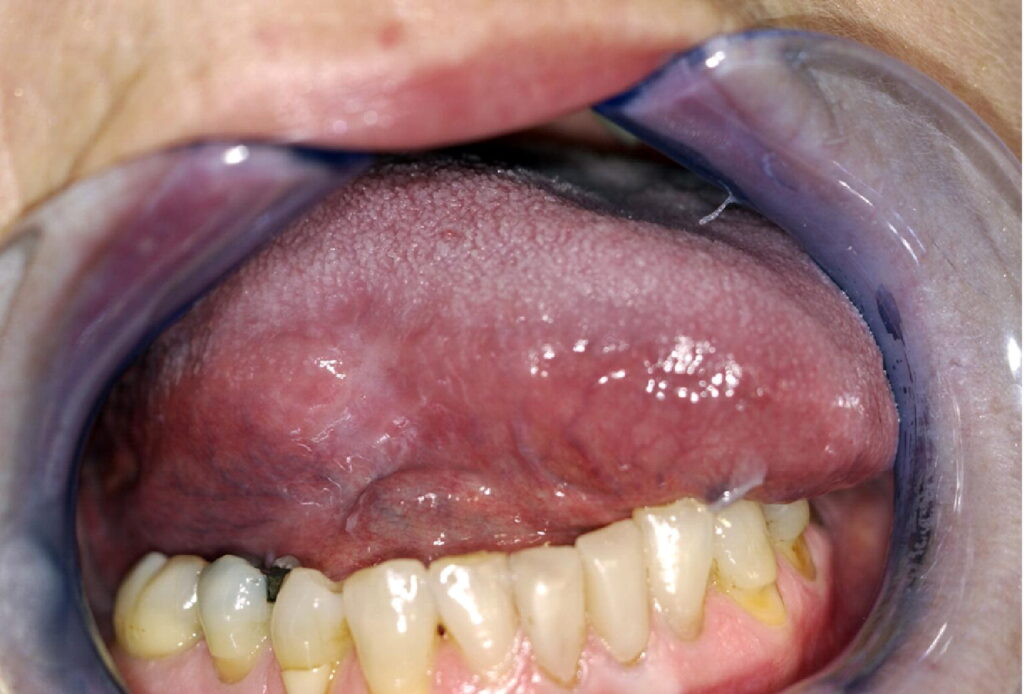WHAT IS LEUKOPLAKIA?
With leukoplakia, thickened, white patches form on your gums, the inside of your cheeks, the base of your mouth, and, at times, your tongue. These patches cannot be scraped off.
Doctors do not know what causes leukoplakia but consider the chronic irritation from tobacco — whether smoked, dipped, or chewed — to be the primary culprit in its development.
Most leukoplakia patches are noncancerous (benign), although some exhibit early signs of cancer. Cancers on the bottom of the mouth could happen next to areas of leukoplakia. White areas mixed in with red areas (speckled leukoplakia) might suggest the potential for cancer. So, it is best to consult your dentist or primary care professional if you have uncommon, continuous changes in your mouth.
A type of leukoplakia known as hairy leukoplakia, otherwise known as oral hairy leukoplakia, mainly affects people whose immune systems have been weakened by disease, particularly HIV/AIDS.

SYMPTOMS
Leukoplakia generally happens on your gums, the insides of your cheeks, the bottom of your mouth — beneath the tongue — and, at times, your tongue. It is not generally painful and might go unnoticed for a while.
Leukoplakia might appear:
- White or grayish in patches that cannot be wiped away
- Irregular or flat-textured
- Thickened or hardened in areas
- Alongside raised, red lesions (speckled leukoplakia or erythroplakia), which are more likely to show precancerous changes
Hairy leukoplakia
Hairy leukoplakia causes fuzzy, white patches that resemble folds or ridges, generally on the sides of your tongue. It is usually confused with the oral thrush, an infection marked by creamy white patches that could be wiped away, which is also common in people with a weakened immune system.

WHEN SHOULD YOU SEE A DOCTOR?
Even though leukoplakia does not generally cause discomfort, sometimes it could indicate a more severe condition.
Consult your dentist or primary care professional if you have any of the following:
- White plaques or sores in your mouth that do not heal on their own within two weeks
- Lumps or white, red or dark patches or spots in your mouth
- Continuous changes in the tissues of your mouth.
- Ear pain when swallowing
- Progressive decrease in the ability to open your jaw
CAUSES
However, the cause of leukoplakia is unknown, chronic irritation, like from tobacco use, including smoking and chewing, seems to be responsible for most cases. Usually, everyday users of smokeless tobacco products ultimately develop leukoplakia where they hold the tobacco against their cheeks.
Other causes might include chronic irritation from:
- Jagged, broken, or pointed teeth rubbing on the tongue surface
- Broken or ill-fitting dentures
- Long-term alcohol use
- Your dentist can talk with you about what might be causing leukoplakia in your case.

Hairy leukoplakia
Hairy leukoplakia is caused due to infection with the Epstein-Barr virus (EBV). Once you have been infected with EBV, the virus remains in your body for a lifetime. Generally, the virus is inactive, but if your immune system is weakened, particularly by HIV/AIDS, the virus could become reactivated, resulting in conditions like hairy leukoplakia.
RISK FACTORS
Tobacco use, especially smokeless tobacco, exposes you to a high risk of leukoplakia and oral cancer. Long-term alcohol use raises your risk, and drinking alcohol combined with smoking increases your risk even more.
Hairy leukoplakia
People with HIV/AIDS are particularly likely to develop hairy leukoplakia. However, the use of antiretroviral drugs has reduced the number of cases, hairy leukoplakia still affects a number of HIV-positive people, and it might be one of the first signs of HIV infection.
COMPLICATIONS
Leukoplakia generally does not cause permanent damage to tissues in your mouth. Although, leukoplakia raises your risk of oral cancer. Oral cancers usually develop near leukoplakia patches, and the patches themselves might show cancerous changes. Even after leukoplakia patches are removed, the risk of oral cancer still remains.
Hairy leukoplakia
Hairy leukoplakia is not likely to result in cancer. But it might indicate HIV/AIDS.

PREVENTION
You might be able to stop leukoplakia if you avoid all tobacco products or alcohol use. Speak to your doctor about methods to help you quit. If you continue to smoke or chew tobacco or drink alcohol, have recurring dental check-ups. Oral cancers are generally painless until fairly advanced, so quitting tobacco and alcohol is a better prevention strategy.
Hairy leukoplakia
If you have a weakened immune system, you might not be able to prevent hairy leukoplakia, but identifying it early could help you receive appropriate treatment.
DIAGNOSIS
Most usually, your doctor diagnoses leukoplakia by:
- Checking the patches in your mouth
- Attempting to wipe off the white patches
- Discussing your medical history and risk factors
- Ruling out other potential causes
- Testing for cancer
If you have leukoplakia, your doctor will probably test for early signs of cancer by:
- Oral brush biopsy – This includes removing the cells from the surface of the lesion with a tiny, rotating brush. This is a non-invasive procedure but does not always lead to a definitive diagnosis.
- Excisional biopsy – This includes surgically removing tissue from the leukoplakia patch or removing the whole patch if it is tiny. An excision biopsy is more comprehensive and generally leads to a definitive diagnosis.
If the biopsy is positive for cancer and your doctor performed an excisional biopsy that removed the whole leukoplakia patch, you might not require further treatment. If the patch is big, you might be referred to an oral surgeon or ear, nose, and throat (ENT) specialist for treatment.
Hairy leukoplakia
If you have hairy leukoplakia, you will probably be evaluated for conditions that might contribute to a weakened immune system.
TREATMENT
Leukoplakia treatment is most successful when a lesion is found and treated early when it is tiny. Regular check-ups are crucial, as is routinely inspecting your mouth for areas that do not look normal.
For most people, removing the source of irritation ― like stopping tobacco or alcohol ― clears the condition.
When this is not effective or if the lesions show early signs of cancer, the treatment plan might involve:
- Removal of leukoplakia patches – Patches might be removed using a scalpel, a laser, or an extremely cold probe that freezes and destroys cancer cells (cryoprobe).
- Follow-up visits to check the area – Once you have had leukoplakia, recurrences are common.
Treating hairy leukoplakia
Generally, you do not require treatment for hairy leukoplakia. The condition usually causes no symptoms and is not likely to lead to mouth cancer.
If your doctor recommends treatment, it might include:
- Medication – You might take a pill that affects your whole system (systemic medication), like antiviral medications. These medications could suppress the Epstein-Barr virus, the cause of hairy leukoplakia. Topical treatment might also be used.
- Follow-up visits – Once you stop treatment, the white patches of hairy leukoplakia might return. Your doctor might recommend regular follow-up visits to monitor changes to your mouth or ongoing therapy to stop leukoplakia patches from returning.
If you or anyone you know is suffering from leukoplakia, our expert providers at Specialty Care Clinics will take care of your health and help you recover.
Call us on (469) 545-9983 to book an appointment with our specialists.
